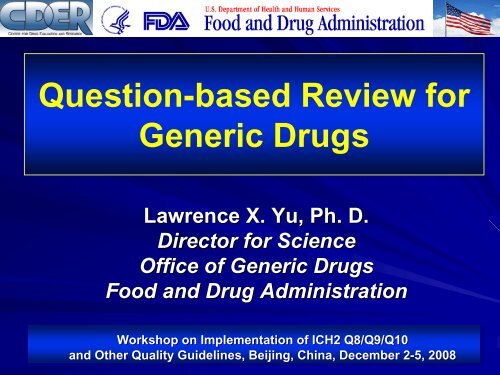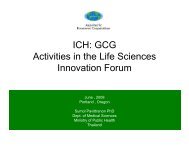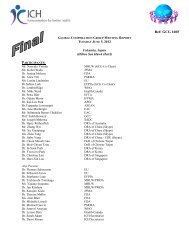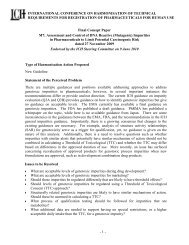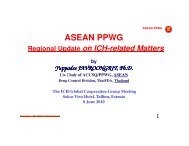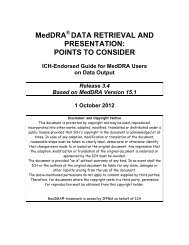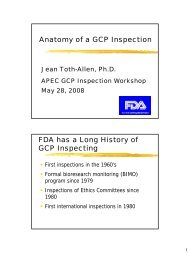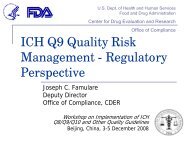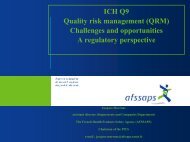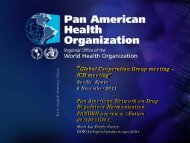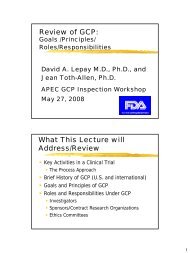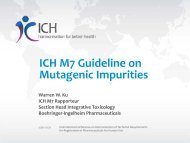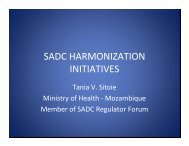US FDA's Question-based Review for Generic Drugs - ICH
US FDA's Question-based Review for Generic Drugs - ICH
US FDA's Question-based Review for Generic Drugs - ICH
You also want an ePaper? Increase the reach of your titles
YUMPU automatically turns print PDFs into web optimized ePapers that Google loves.
<strong>Question</strong>-<strong>based</strong> <strong>Review</strong> <strong>for</strong><br />
<strong>Generic</strong> <strong>Drugs</strong><br />
Lawrence X. Yu, Ph. D.<br />
Director <strong>for</strong> Science<br />
Office of <strong>Generic</strong> <strong>Drugs</strong><br />
Food and Drug Administration<br />
Workshop on Implementation of <strong>ICH</strong>2 Q8/Q9/Q10<br />
and Other Quality Guidelines, Beijing, China, December 2-5, 2008<br />
1
Total Prescription <strong>Drugs</strong> Dispensed<br />
in the United States<br />
Brand<br />
<strong>Generic</strong><br />
Total Prescription Dispensed (%)<br />
100<br />
90<br />
80<br />
70<br />
60<br />
50<br />
40<br />
30<br />
20<br />
10<br />
0<br />
1999 2000 2001 2002 2003 2004 2005 2006 2007<br />
Year<br />
2
<strong>Generic</strong> Drug Price<br />
In 2007, the U.S. generic drug sales have<br />
reached $58.5 billion<br />
In 2006, the average retail price of a generic<br />
prescription drug was $32.23 while the average<br />
retail price of a brand name prescription drug was<br />
$111.02.<br />
Average Relative Price Per Dose (%)<br />
100<br />
90<br />
80<br />
70<br />
60<br />
50<br />
40<br />
30<br />
20<br />
10<br />
0<br />
1<br />
3<br />
5<br />
7<br />
9<br />
11<br />
13<br />
15<br />
17<br />
19<br />
Number of <strong>Generic</strong> Sponsors<br />
3
Drug Price Competition and Patent<br />
Restoration Act of 1984<br />
Provisions <strong>for</strong> extending the term of a patent to reflect regulatory<br />
delays encountered in obtaining marketing approval by the FDA;<br />
a statutory exemption from patent infringement <strong>for</strong> activities<br />
associated with regulatory marketing application. Thus, generic<br />
sponsors may start to work on a generic version of an approved<br />
brand name drug any time during the life of the patent, so long as<br />
that work furthers compliance with FDA regulations;<br />
establishment of mechanisms to challenge the validity of a<br />
pharmaceutical patent; and a reward <strong>for</strong> disputing the validity,<br />
en<strong>for</strong>ceability, or infringement of a patented and approved drug; and<br />
the FDA’s s certain authorities to offer<br />
periods of marketing exclusivity <strong>for</strong> a<br />
pharmaceutical independent of the<br />
rights conferred by patents.<br />
4
FDA OGD Organization<br />
Director<br />
Gary Buehler, R.Ph.<br />
Director <strong>for</strong> Science<br />
Lawrence X. Yu, Ph.D.<br />
Deputy Director<br />
Robert West, R.Ph.<br />
Director<br />
Division of Labeling<br />
& Program Support<br />
Peter Rickman<br />
Associate Director<br />
Medical Affairs<br />
Dena Hixon, M.D.<br />
Director<br />
Division of<br />
Bioequivalence I<br />
Dale Conner, Pharm.D.<br />
Director<br />
Division of<br />
Bioequivalence II<br />
Barbara Davit, Ph.D.<br />
Team Leader<br />
Microbiology<br />
Neal Sweeney, Ph.D.<br />
Director<br />
Division of<br />
Chemistry I<br />
Rashmi Patel, Ph.D.<br />
Director<br />
Division of<br />
Chemistry II<br />
Florence Fang<br />
Director<br />
Division of<br />
Chemistry III<br />
Vilayat Sayeed, Ph.D.<br />
5
FDA OGD Mission, Vision, and<br />
Mission<br />
Value<br />
– Ensure that safe and effective generic drugs are<br />
available <strong>for</strong> the American people.<br />
Vision<br />
– Strives to serve the public by making significant<br />
enhancements in human health through excellence<br />
and innovation in drug regulations<br />
Value<br />
– accountability, diversity, equity, excellence, integrity,<br />
and transparency<br />
6
<strong>Generic</strong> Drug Approval<br />
Brand Name Drug<br />
NDA Requirements<br />
<strong>Generic</strong> Drug<br />
ANDA Requirements<br />
1. Chemistry 1. Chemistry<br />
2. Manufacturing 2. Manufacturing<br />
3. Controls 3. Controls<br />
4. Labeling 4. Labeling<br />
5. Testing 5. Testing<br />
6. Animal Studies<br />
7. Clinical Studies 6. Bioequivalence<br />
8. Bioavailability<br />
7
<strong>Generic</strong> Drug<br />
<strong>Review</strong><br />
Process<br />
CITIZEN<br />
PETITION
What is Quality by Design?<br />
<strong>ICH</strong> Q8 ®<br />
– The pharmaceutical Quality by Design (QbD) is a<br />
systematic approach to development that begins with<br />
predefined objectives and emphasizes product and<br />
process understanding and process control, <strong>based</strong> on<br />
sound science and quality risk management<br />
Quality by Design includes defining of target<br />
product profile, designing product and process,<br />
identifying critical attributes (design space), and<br />
controlling manufacturing process<br />
9
Quality by Design<br />
FDA’s Pharmaceutical cGMP<br />
<strong>for</strong> the 21 st Century<br />
QbD Initiative<br />
<strong>Generic</strong> Sponsor:<br />
Implementing<br />
QbD in development<br />
and manufacturing<br />
Development of <strong>Question</strong><br />
-<strong>based</strong> <strong>Review</strong><br />
FDA OGD:<br />
Developed a <strong>Question</strong><strong>based</strong><br />
<strong>Review</strong> System<br />
that assesses sponsor’s<br />
QbD ANDAs<br />
10
<strong>Question</strong>-<strong>based</strong> <strong>Review</strong><br />
<strong>Question</strong>-<strong>based</strong> <strong>Review</strong> (QbR) is a general<br />
framework <strong>for</strong> a science and risk-<strong>based</strong><br />
assessment of product quality<br />
QbR contains the important scientific and<br />
regulatory review questions to<br />
– Comprehensively assess critical <strong>for</strong>mulation and<br />
manufacturing process variables<br />
– Set regulatory specifications relevant to quality<br />
– Determine the level of risk associated with the<br />
manufacture and design of the product<br />
11
QbR Principles<br />
Quality built in by design, development,<br />
and manufacture and confirmed by testing<br />
Risk-<strong>based</strong> approach to maximize<br />
economy of time, ef<strong>for</strong>t, and resources<br />
Preserve the best practices of current<br />
review system and organization<br />
Best available science and wide<br />
consultation to ensure high quality<br />
questions<br />
12
<strong>Question</strong>s Come First<br />
Say What You Do and Do What You Say<br />
<strong>Question</strong>s guide reviewers<br />
– Prepare a consistent and comprehensive evaluation<br />
of the ANDA<br />
– Assess critical <strong>for</strong>mulation & manufacturing variables<br />
<strong>Question</strong>s guide industry<br />
– Recognize issues OGD generally considers critical<br />
– Direct industry toward QbD<br />
<strong>Question</strong>s in<strong>for</strong>m readers of the review<br />
– How QbD was used in the ANDA<br />
– Provide the basis <strong>for</strong> a risk assessment<br />
13
<strong>Question</strong>-<strong>based</strong> <strong>Review</strong> System<br />
Quality by<br />
Design<br />
QbR<br />
<strong>Question</strong>s<br />
Quality<br />
Overall<br />
Summary<br />
Novel Risk<br />
Assessment<br />
Post Approval<br />
Changes<br />
14
ANDAs under QbR<br />
Encouraging all ANDAs be submitted in the CTD<br />
<strong>for</strong>mat and preferably electronic CTD to support<br />
<strong>Question</strong>-<strong>based</strong> <strong>Review</strong><br />
– The 1999 and 2002 Guidances <strong>for</strong> Industry;<br />
Organization of an ANDA have been removed from<br />
the Regulatory Guidance page<br />
– The ANDA Checklist <strong>for</strong> Completeness and<br />
Acceptability of an Application <strong>for</strong> Filing<br />
can be found on the OGD web page (4/19/2006)<br />
http://www.fda.gov/cder/ogd/<br />
15
Diagram of the <strong>ICH</strong> Common Technical Document<br />
QOS<br />
Summary of Critical CMC<br />
Elements<br />
Body of Data<br />
Detailed CMC Submission<br />
Package<br />
16
QbR ANDA Submission<br />
% QbR ANDA<br />
100<br />
90<br />
80<br />
70<br />
60<br />
50<br />
40<br />
30<br />
20<br />
10<br />
0<br />
QbR ANDA Submissions in 2007 and 2008<br />
7-Jan<br />
Mar<br />
May<br />
July<br />
Sep<br />
Nov<br />
Time<br />
8-Jan<br />
8-Mar<br />
8-May<br />
8-Jul<br />
17
First 40 QbR Approvals<br />
25<br />
QbR Approvals<br />
(Median Approval Time = 13 M)<br />
Approval Time<br />
20<br />
15<br />
10<br />
5<br />
0<br />
1 3 5 7 9 111315171921232527293133353739<br />
QbR ANDA Approval #<br />
First 40 QbR approvals; not necessary suggesting<br />
that QbR reduce review time<br />
18
QbD <strong>Question</strong>s Under QbR<br />
Define target product quality profile<br />
– What attributes should the drug product possess?<br />
Design and develop product and manufacturing<br />
process to meet target product quality profile<br />
– How was the product designed to have these<br />
attributes?<br />
– Were alternative <strong>for</strong>mulations or mechanisms<br />
investigated?<br />
– How were the excipients and their grades selected?<br />
– How was the final <strong>for</strong>mulation optimized?<br />
19
QbD <strong>Question</strong>s Under QbR<br />
(Continued)<br />
Design and develop product and<br />
manufacturing process to meet target<br />
product quality profile<br />
– What are the unit operations in the drug<br />
product manufacturing process?<br />
– Why was the manufacturing process selected?<br />
– How are the unit operations related to the<br />
drug product quality?<br />
20
QbD <strong>Question</strong>s Under QbR<br />
(Continued)<br />
Identify and control critical raw material<br />
attributes, process parameters, and sources of<br />
variability<br />
– Which properties or physicochemical characteristics<br />
of the drug substance affect drug product<br />
development, manufacture, or per<strong>for</strong>mance?<br />
– What evidence supports compatibility between the<br />
excipients and the drug substance?<br />
– How were the critical process parameters identified,<br />
monitored, and controlled?<br />
21
QbD <strong>Question</strong>s Under QbR<br />
(Continued)<br />
The process is monitored and adapted to<br />
produce consistent quality over time<br />
– What are the in-process tests and/or controls that<br />
ensure each step is successful?<br />
– What is the scale-up experience with the unit<br />
operations in this process?<br />
– In the proposed scale up plan what operating<br />
parameters will be adjusted to ensure the product<br />
meets all in-process controls and final product<br />
specifications?<br />
– What evidence supports the plan to scale up the<br />
process to commercial scale?<br />
22
Traditional CMC <strong>Review</strong> to QbR<br />
Assessment<br />
No PD Inf<br />
Assess QbD<br />
<strong>Review</strong>er<br />
Sponsor<br />
Assessment spec<br />
Summary<br />
Body of Data<br />
Assess spec<br />
per<strong>for</strong>mance<br />
Summary<br />
QbD<br />
Body of Data<br />
QbD<br />
<strong>Review</strong>er<br />
Sponsor<br />
Traditional<br />
QbR<br />
23
OGD Model QOS<br />
Model QOS <strong>for</strong> ER Product (1/2006)<br />
– http: //www.fda.gov/cder/ogd/OGD_Model_Quality_Overall_Summary.pdf<br />
Model QOS <strong>for</strong> IR Product (3/2006)<br />
– http: //www.fda.gov/cder/ogd/OGD_Model_QOS_IR_Product.pdf<br />
24
QbR Risk Assessment<br />
One goal of risk assessment is to allocate<br />
scarce reviewer resources to benefit the<br />
public<br />
– More emphasis on<br />
Critical dose drugs (NTI)<br />
“Complex” dosage <strong>for</strong>ms/delivery systems<br />
– Less yet appropriate emphasis on<br />
Solution products and Solid Oral IR Dosage Forms<br />
– Reducing supplements <strong>for</strong> minor and some<br />
moderate post-approval changes<br />
25
Advantages of QbR<br />
<strong>Question</strong>s guide reviewers<br />
– Prepare a consistent and comprehensive evaluation<br />
of the ANDA<br />
– Assess critical <strong>for</strong>mulation & manufacturing variables<br />
<strong>Question</strong>s guide industry<br />
– Recognize issues OGD generally considers critical<br />
– Direct industry toward QbD<br />
<strong>Question</strong>s in<strong>for</strong>m readers of the review<br />
– How QbD was used in the ANDA<br />
– Provide the basis <strong>for</strong> a risk assessment<br />
26
QbR <strong>Question</strong> Revision 2009<br />
External committee of FDA scientists to review<br />
– QbR questions<br />
– sponsors answers to the QbR questions<br />
– use of the QbR questions in ANDA review<br />
OGD WG to recommend QbR questions revision<br />
to<br />
– encourage firms to incorporate QbD in their ANDA<br />
submissions<br />
– enable better evaluation of QbD by OGD reviewers<br />
Public comment process be<strong>for</strong>e question<br />
revision<br />
27
Citizen’s s Petitions<br />
21 CFR 10.30 defines content and <strong>for</strong>mat of<br />
petition<br />
Request by individual <strong>for</strong> Fed Government to<br />
take an action articulated in the petition<br />
FDAAA requires FDA to respond within 6<br />
months.<br />
Publicly available at ‘Dockets’<br />
– www.regulations.gov<br />
28
FDA Application Integrity Policy<br />
The policy focuses on the integrity of data and<br />
in<strong>for</strong>mation in applications submitted <strong>for</strong> FDA’s<br />
review and approval<br />
Fraud, untrue statements of material facts,<br />
bribery, and illegal gratuities<br />
FDA’s s actions<br />
– Refuse to approve the application (in the case of a<br />
pending application)<br />
– Proceed to withdraw approval (in the case of an<br />
approved application)<br />
– Seek recalls of marketed products etc.<br />
– Others<br />
29
Summary<br />
FDA OGD’s generic drug review is <strong>based</strong> on<br />
sound science and regulations<br />
Product design, regulatory review, quality<br />
standards, and cGMP contribute to the high<br />
quality of generic drugs<br />
QbR is a new quality assessment system that<br />
focuses on critical pharmaceutical quality<br />
attributes. It is trans<strong>for</strong>ming the ANDA CMC<br />
review into a modern, science- and risk-<strong>based</strong><br />
pharmaceutical quality assessment system<br />
30


